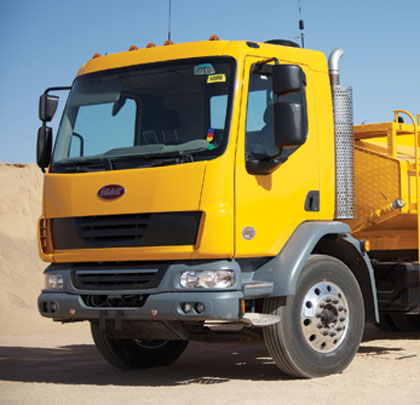“Son, pull the fuel and lube truck over and top off the DEF tank on the blade and then make sure that water truck goes through a regen cycle on the DPF.” This is not a conversation you remember your granddad having, but you might hear it today.
Today’s new fuel and lube trucks are not the same as they were as recently as 5 years ago. Emissions standards, fuel consumption, telematics with fluid tracking, and DEF (Diesel Exhaust Fluid) have fuel and lube truck builders scrambling to offer the best configuration for the modern contractor.
Not only are specifications and capabilities changing, but fuel and lube trucks must do more than ever before and be very dependable. There is an increased demand for mobile service in the field. Equipment used to come back into the shop more frequently, but contractors are realizing they can be more economical completing the work on the jobsite.
As one construction contractor recently said, “Our fuel and lube trucks are like our fire trucks and ambulances—when one goes down, we are in a world of hurt.” Having a fuel and lube truck that is dependable is of ultimate importance when factoring in contract loss penalties. “When you start calculating penalties from not moving dirt, because you can’t get fuel to the equipment, the numbers are staggering.”
DIESEL EXHAUST FLUID (DEF)
By now, most all contractors are making arrangements for DEF, whether filling up the Ford work truck or making provisions to get bulk DEF out to the jobsite. DEF is here to stay and fuel and lube truck builders have started to adapt. Stainless steel and high density plastic are the materials that builders are electing to use for DEF bulk transfer tanks and equipment, because steel and aluminum will harm the effectiveness of DEF.
As part of the challenge, body providers have to deal with the characteristics of DEF in cold weather: DEF freezes at 11 degrees F, but takes 18 hours to freeze. Freezing doesn’t hurt the makeup of DEF; it thaws back to its original state. However, work can’t stop if it’s below 11 degrees, so builders are installing heaters in the DEF tanks to ensure that when they get to the dozer, and it’s a balmy 5 degrees out, that crucial DEF fluid will dispense to keep that dozer going.
POWER OPTIONS
DPF filters and the contractors’ budget do not like engine idle time. Fuel and lube trucks traditionally have PTO-driven hydraulics to run delivery pumps and compressors, meaning the truck is idling and reaching a higher RPM while servicing for most of the day at the jobsite.
Stand-alone air power and compressors on trucks are a very good option that can have multiple advantages. A stand-alone air compressor, like a VMAC Raptair 60, uses its own 3 cylinder Kubota diesel engine, and will use less than a third of the fuel that a truck engine will use while performing fueling and servicing during the course of the day. According to Mike Pettigrew, VMAC Sales, idling a truck for PTO availability just 1 hour uses 1.2 gallons of diesel. This is assuming the engine isn’t reaching a higher RPM for PTO demand. Also for today’s new chassis with diesel particulate filters, idling is not something these new trucks like. Idling when a DPF filter is trying to regen can plug the filter very quickly.

Emissions standards, fuel consumption, telematics with fluid tracking, and DEF have fuel and lube truck builders scrambling to offer the best configuration for the modern contractor.
TELEMATICS
While saving fuel when operating your fuel and lube truck is a bonus for the contractor and can mean big savings, it is even more valuable to the contractor to know exactly how much fuel and oil each asset is consuming. Incorporating telematics and electronic fuel controls into fuel and lube body builds is happening now and will continue to gain popularity.
OEM Controls Data Delivery designs the GoPod and software that can track machine utilization, location, fuel consumption, oil consumption, and jobsite data for all the machines being serviced. “The data is easily delivered to any tablet or phone using IOS, Android, or Windows; this makes things even easier for service managers,” says Chris Juliano of OEM Controls. “Once a luxury, smartphones and tablets are now showing up on most construction sites. These smart devices are the hardware that easily relays information to contractors accounting programs,” Juliano says.
CUSTOMIZATION
All of these industry demands will be met by today’s progressive truck builders, and the customization of the product for the end user will continue to increase. As contractors specialize in different activities in different parts of the world, their needs change, and so does their requirement for a fuel and lube body. In addition to DEF, telematics, and fuel efficiency, requirements evolving include heated lube bodies, longer hose reels, larger oil quantities, and more fuel.
Today’s fuel and lube vehicle is certainly not your granddad’s truck, what will the conversation sound like for the next generation? ■
About The Author Aaron Sage is chief operations officer of Sage Oil Vac, designed and manufactured in West Texas. The Sage Oil Vac team is still family owned and operated to serve many markets, such as agriculture, construction, road building, oil & gas, mobile oil change business, the military, and gearbox maintenance, in the U.S. and Canada. Sage Oil Vac, Inc. has international distributors in Europe, Canada, China, and Australia.
Modern Contractor Solutions, September 2014
Did you enjoy this article?
Subscribe to the FREE Digital Edition of Modern Contractor Solutions Magazine!



